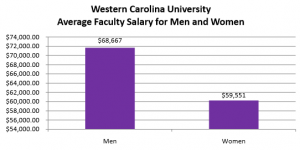For years, women around the world have actively participated in a battle for equal rights and treatment in professional settings. Women have been doing the same amount of work, sometime more, as men yet they still receive less pay. This issue has been noted and demonstrated in many large cities, but it was a surprise it is present in a university setting like Western Carolina University.
In 2011, WCU’s chapter of American Association of University Women (AAUW) requested that the university participate in a gender equality salary survey. The survey included the entire population of all WCU’s full-time staff in each college or school. The surveys factored in department, rank, gender, degree, the date of their degree, tenure status, and title.
The results showed that male faculty member’s average salary averaged out to $68,667 while women only averaged out to $59,551. Overall, men earned higher average salaries for doing the same task as women.
“I feel like in the 21st century women’s equality should not be a problem,” says Norman Falls, a student at WCU. “Meaning that, pay should not be based on gender, sex, age or color. At this point we all should be on the same page. Equality for all is a trait that America stands on. We should not be degrading the women of America, of even WCU, by pay[ing] them less than a man.”
Dr. Laura Wright, associate professor and department head at the English Department, in her commentary for the Faculty Forum wrote that the “gap at WCU isn’t really abnormal – in fact, we’re in better shape than lots of places.”
“So we’re doing better than the national average cited above, and while the inequity we do see is not “statistically significant” or legally actionable, gender inequity very much exists at WCU. My sense is that the body of people within our institution who might have believed men should earn more than women is shrinking, and I’m optimistic about a generational shift that will keep women from starting at this particular disadvantage,” wrote Wright.
She explained that at WCU women earn 87 cents for every dollar earned by men while according to Jonah Newman, “at doctoral universities . . . women across all faculty ranks make about 78 cents on the dollar, nearly the national average ratio for all women.”
As Dr. Hal Herzog, professor from Psychology department, this difference in pay may be legal ( ‘in compliance with the legal regulations’) but it doesn’t mean it is right.
Students on campus did not believe that this was fair treatment of professors and faculty at WCU. Some students even went on to say that most of their female professors performed better and more efficiently than male professors here on campus. However, some students expressed different opinions if their spouse made more money than them in the future.
“I don’t think professors should be paid differently according to their gender,” says Devyn Jones. “I do think it would feel weird for a women to bring home more money than I do. In our society men are supposed to bring home the money. It’s weird for a women to step outside of the comfort zone.”
When some students expressed their views American’s face when it comes to the issue of equal pay. The topic contradicts itself. Individuals say they want equal pay but follow traditional stances on issues like this.
“I was not aware in any way, when you work in this industry [higher education] you should educate yourself. We don’t think about it [salary], we do what we do because we love what we do. So, you wouldn’t think to compare yourself to other people,” Tacquice Davis, Assistant Director for Leadership Programs.
According to the study from AAUW, wage inequality is present in every state; that inequality is more prominent with the women of color; it happens in all occupations no mater the level of education and that pay gap grows with age.
Related stories:
Faculty Forum: Responses to the January Faculty Forum about Gender (In)Equities and Compliance by Laura Wright and Hal Herzog



